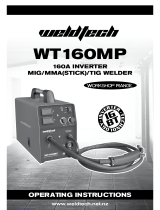9.7.12 OKC Capacitor Board ......................................................................................... 9-34
9.7.13 Gas Valves .......................................................................................................... 9-35
9.8 TESTING PROCEDURES .................................................................................... 9-36
9.8.1 Initial Set up conditions ..................................................................................... 9-36
9.8.2 Power-UP Procedure ......................................................................................... 9-37
9.9 POWER UP FAULTS .......................................................................................... 9-39
9.9.1 Mains Power fuses blow/ breaker trips when SW1 is turned on: ..................... 9-39
9.9.2 Unit is completely inactive, front panel display is off, no output voltage. ....... 9-39
9.10 SMAW PROCESS TEST ...................................................................................... 9-41
9.10.1 SMAW Process Test: LED status ........................................................................ 9-41
9.10.2 SMAW Process Test Problems ........................................................................... 9-42
9.11 GTAW LIFT TIG PROCESS TEST ......................................................................... 9-43
9.11.1 GTAW LIFT TIG Process Test: LED status ........................................................... 9-43
9.11.2 GTAW LIFT TIG Process Test Problems .............................................................. 9-44
9.12 GMAW MIG PROCESS TEST ............................................................................. 9-45
9.12.1 GMAW Process Test: LED status ....................................................................... 9-45
9.12.2 GMAW Process Test Problems .......................................................................... 9-45
9.13 COMPONENT, SUB-ASSEMBLY TESTS .............................................................. 9-48
9.13.1 Power Cord/Plug, Power Switch, and EMI Board Test ...................................... 9-48
9.13.2 Primary Rectifier Test ........................................................................................ 9-49
9.13.2.1 BR1, BR2 Test Procedure ................................................................................ 9-51
9.13.3 IPS Board Test .................................................................................................... 9-53
9.13.4 Main Power Board Test ..................................................................................... 9-54
9.13.5 Control Board Test ............................................................................................. 9-58
9.13.6 UI Board Test ..................................................................................................... 9-60
9.13.7 Output Diode Board Test ................................................................................... 9-61
9.13.8 Current Sensor Test ........................................................................................... 9-62
9.13.9 Remote Control Trigger Test ............................................................................. 9-63
9.14 CALIBRATION .................................................................................................. 9-64
SECTION 10 ORDERING SPARE PARTS
10.1 SPARE PARTS ................................................................................................... 10-1
10.2 WEAR PARTS ................................................................................................... 10-3
10.3 ACCESSORIES ................................................................................................... 10-4
10.4 REPLACEMENTS PARTS .................................................................................... 10-5





















